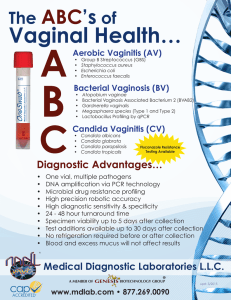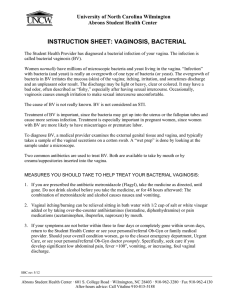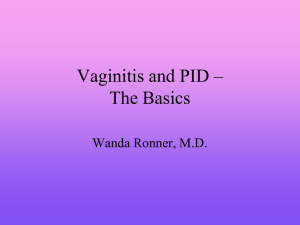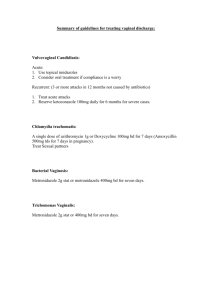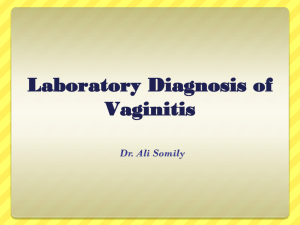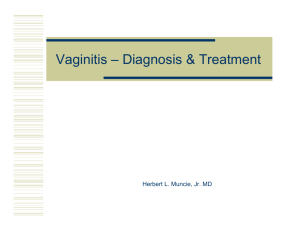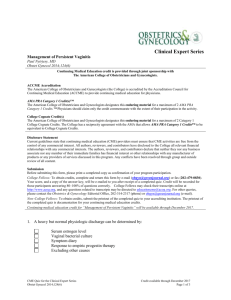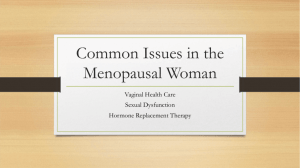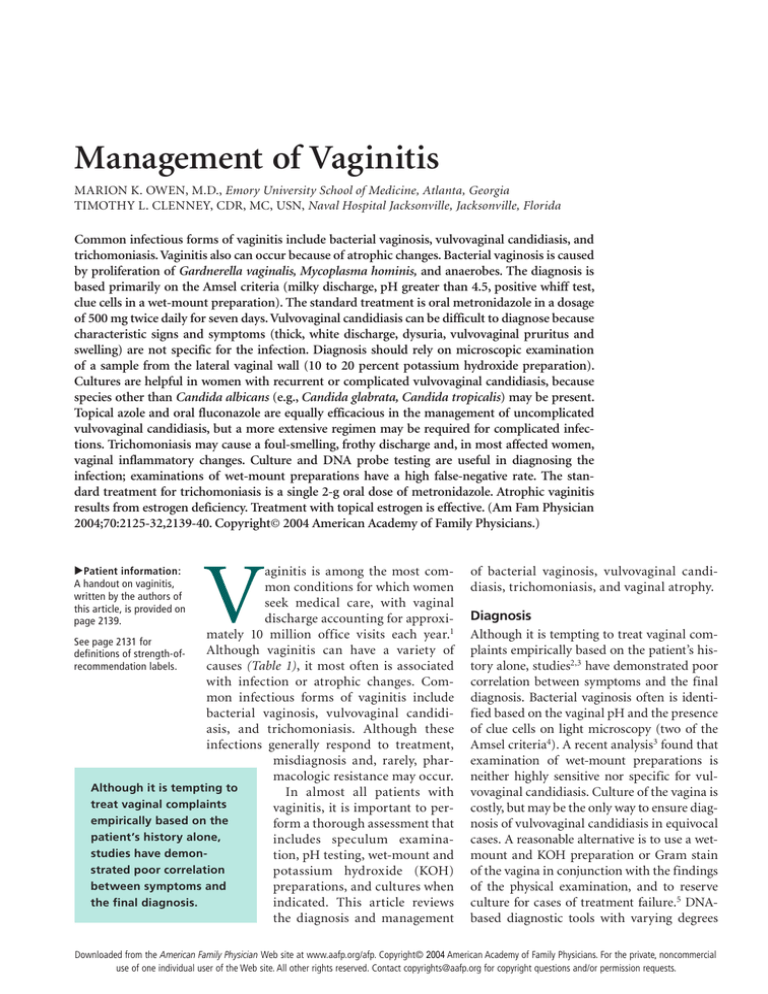
Management of Vaginitis
MARION K. OWEN, M.D., Emory University School of Medicine, Atlanta, Georgia
TIMOTHY L. CLENNEY, CDR, MC, USN, Naval Hospital Jacksonville, Jacksonville, Florida
Common infectious forms of vaginitis include bacterial vaginosis, vulvovaginal candidiasis, and
trichomoniasis. Vaginitis also can occur because of atrophic changes. Bacterial vaginosis is caused
by proliferation of Gardnerella vaginalis, Mycoplasma hominis, and anaerobes. The diagnosis is
based primarily on the Amsel criteria (milky discharge, pH greater than 4.5, positive whiff test,
clue cells in a wet-mount preparation). The standard treatment is oral metronidazole in a dosage
of 500 mg twice daily for seven days. Vulvovaginal candidiasis can be difficult to diagnose because
characteristic signs and symptoms (thick, white discharge, dysuria, vulvovaginal pruritus and
swelling) are not specific for the infection. Diagnosis should rely on microscopic examination
of a sample from the lateral vaginal wall (10 to 20 percent potassium hydroxide preparation).
Cultures are helpful in women with recurrent or complicated vulvovaginal candidiasis, because
species other than Candida albicans (e.g., Candida glabrata, Candida tropicalis) may be present.
Topical azole and oral fluconazole are equally efficacious in the management of uncomplicated
vulvovaginal candidiasis, but a more extensive regimen may be required for complicated infections. Trichomoniasis may cause a foul-smelling, frothy discharge and, in most affected women,
vaginal inflammatory changes. Culture and DNA probe testing are useful in diagnosing the
infection; examinations of wet-mount preparations have a high false-negative rate. The standard treatment for trichomoniasis is a single 2-g oral dose of metronidazole. Atrophic vaginitis
results from estrogen deficiency. Treatment with topical estrogen is effective. (Am Fam Physician
2004;70:2125-32,2139-40. Copyright© 2004 American Academy of Family Physicians.)
V
aginitis is among the most common conditions for which women
seek medical care, with vaginal
discharge accounting for approximately 10 million office visits each year.1
See page 2131 for
Although vaginitis can have a variety of
definitions of strength-ofcauses (Table 1), it most often is associated
recommendation labels.
with infection or atrophic changes. Common infectious forms of vaginitis include
bacterial vaginosis, vulvovaginal candidiasis, and trichomoniasis. Although these
infections generally respond to treatment,
misdiagnosis and, rarely, pharmacologic resistance may occur.
Although it is tempting to
In almost all patients with
treat vaginal complaints
vaginitis, it is important to perempirically based on the
form a thorough assessment that
patient’s history alone,
includes speculum examinastudies have demontion, pH testing, wet-mount and
strated poor correlation
potassium hydroxide (KOH)
between symptoms and
preparations, and cultures when
indicated. This article reviews
the final diagnosis.
the diagnosis and management
▲
Patient information:
A handout on vaginitis,
written by the authors of
this article, is provided on
page 2139.
of bacterial vaginosis, vulvovaginal candidiasis, trichomoniasis, and vaginal atrophy.
Diagnosis
Although it is tempting to treat vaginal complaints empirically based on the patient’s history alone, studies2,3 have demonstrated poor
correlation between symptoms and the final
diagnosis. Bacterial vaginosis often is identified based on the vaginal pH and the presence
of clue cells on light microscopy (two of the
Amsel criteria4). A recent analysis3 found that
examination of wet-mount preparations is
neither highly sensitive nor specific for vulvovaginal candidiasis. Culture of the vagina is
costly, but may be the only way to ensure diagnosis of vulvovaginal candidiasis in equivocal
cases. A reasonable alternative is to use a wetmount and KOH preparation or Gram stain
of the vagina in conjunction with the findings
of the physical examination, and to reserve
culture for cases of treatment failure.5 DNAbased diagnostic tools with varying degrees
Downloaded from the American Family Physician Web site at www.aafp.org/afp. Copyright© 2004 American Academy of Family Physicians. For the private, noncommercial
use of one individual user of the Web site. All other rights reserved. Contact copyrights@aafp.org for copyright questions and/or permission requests.
TABLE 1
Causes of Vaginitis
Type of vaginitis
Causes and comments
Vulvovaginal candidiasis
Candida albicans, Candida glabrata,
Candida tropicalis
Gardnerella vaginalis, Mycoplasma
hominis, Mobiluncus species,
Bacteroides species (other than
Bacteroides fragilis)
Trichomonas vaginalis
Estrogen deficiency
Soaps, hygiene products (tampons,
sanitary napkins, latex condoms)
Flat, hyperkeratotic lesions that are
pruritic or painful; associated
vulvar and oral lesions
Sperm, douching, hygiene products
(tampons, sanitary napkins, latex
condoms or diaphragms), dyes,
inhaled allergens, occupational
exposures
Tampons, contraceptive devices,
pessary, others
Bacterial vaginosis
Trichomoniasis
Atrophic vaginitis
Chemical irritation
Lichen planus
(desquamative type)
Allergic vaginitis
Foreign body with or
without infection
or trauma
of sensitivity and specificity also are available. Finally, a recent study6 showed that in
adolescents, vaginal swabs for wet-mount and
KOH preparations may be performed reliably
without speculum examination.
Bacterial Vaginosis
Bacterial vaginosis accounts for 10 to 30
percent of the cases of infectious vaginitis
in women of childbearing age.7 In bacterial
vaginosis, there is a decrease in normal lactobacilli and a proliferation of Gardnerella
The Authors
MARION K. OWEN, M.D., is in private family practice in Atlanta. She received her
medical degree from the University of North Carolina at Chapel Hill School of
Medicine and completed a family medicine residency at Emory University School
of Medicine, Atlanta.
TIMOTHY L. CLENNEY, CDR, MC, USN, is a staff family physician in the family
medicine residency program at the Naval Hospital Jacksonville (Fla.), as well as
assistant professor of family medicine at the Uniformed Services University of
the Health Sciences F. Edward Hébert School of Medicine, Bethesda, Md. Dr.
Clenney received his medical degree from the University of South Florida College
of Medicine, Tampa, and completed a family medicine residency at the Naval
Hospital Jacksonville. He also completed a faculty development fellowship and a
master of public health degree at Emory University.
Address correspondence to Timothy L. Clenney, CDR, MC, USN, 1705 Broad
Water Ct., Orange Park, FL 32003 (e-mail: tclenney@msn.com). Reprints are not
available from the authors.
2126 American Family Physician
www.aafp.org/afp
vaginalis, Mycoplasma hominis, and anaerobes, including Mobiluncus, Bacteroides,
and Peptostreptococcus species.
The Amsel criteria are considered to be
the standard diagnostic approach to bacterial vaginosis and continue to be generally
reliable.7,8 The criteria are as follows: milky,
homogeneous, adherent discharge; vaginal
pH greater than 4.5; positive whiff test (the
discharge typically has a fishy smell); and
presence of clue cells in the vaginal fluid on
light microscopy.4 If three of the four criteria
are met, there is a 90 percent likelihood of
bacterial vaginosis.
The presence of small gram-negative rods
or gram-variable rods and the absence of
longer lactobacilli on a Gram stain of the
vaginal discharge also is highly predictive of
bacterial vaginosis.9 However, this method
of diagnosis is impractical in most family physicians’ offices. Because G. vaginalis commonly is found in asymptomatic
women, culture is not useful.
According to guidelines from the Centers
for Disease Control and Prevention (CDC),10
treatment of bacterial vaginosis is indicated
to reduce symptoms and prevent infectious
complications associated with pregnancy
termination and hysterectomy. Treatment
also may reduce the risk of human immunodeficiency virus (HIV) transmission.10
Thus, it is reasonable to treat asymptomatic
patients who are scheduled for hysterectomy or pregnancy termination or who are
at increased risk for HIV infection;10 other
asymptomatic patients need not be treated.
Treatment
The standard treatment for bacterial vaginosis is metronidazole (Flagyl) in a dosage of 500 mg orally twice daily for seven
days (Table 2).10 Although other treatments
have been shown to have approximately
equivalent efficacy,11-16 they are associated
with higher recurrence rates. These agents
include 0.75 percent metronidazole gel
(MetroGel-Vaginal) and 2 percent clindamycin cream (Cleocin). Less effective alternatives include metronidazole in a single
2-g oral dose, oral clindamycin, and intravaginal clindamycin ovules.
Volume 70, Number 11 � December 1, 2004
Vaginitis
BACTERIAL VAGINOSIS IN PREGNANCY
Bacterial vaginosis has been shown to be a
risk factor for premature labor and perinatal infection.17 Although evidence supports
treatment of high-risk pregnant women with
bacterial vaginosis5 (defined as women who
previously delivered a premature infant),7
the benefits of treating asymptomatic, lowrisk pregnant women is less clear.18-20
A Cochrane review21 concluded that no evidence supports screening all pregnant women
for bacterial vaginosis. Guidelines from the
American College of Obstetricians and Gynecologists22 and the Agency for Healthcare
Research and Quality23 do not recommend
screening in low-risk patients (i.e., those
without symptoms). However, family physicians should be aware that one recent study24
demonstrated a significant reduction in
spontaneous preterm birth and late miscarriage after treatment with oral clindamycin,
300 mg twice daily for five days, in women
with asymptomatic bacterial vaginosis who
were at 12 to 20 weeks of gestation. Therefore, the current recommendations against
screening and treating asymptomatic pregnant women may be reevaluated.
Because of concerns about teratogenicity,
many physicians hesitate to use
Because Gardnerella vagioral metronidazole in women who
nalis commonly is found
are in the first trimester of pregin asymptomatic women,
nancy. However, one meta-analyvaginal culture is not
sis25 showed no increased risk of
useful for diagnosing bacbirth defect in infants exposed to
terial vaginosis.
metronidazole in utero. Vaginal
clindamycin does not reduce the
risk of preterm birth or peripartum infection.19 In fact, the CDC10 advises that topical
clindamycin cream may increase the risk of
prematurity and neonatal infections.
RECURRENT BACTERIAL VAGINOSIS
Recurrent bacterial vaginosis is common and
requires longer treatment (10 to 14 days)
with any of the recommended or alternative
therapies9 (Table 2).10 Although lactobacillus suppositories26 and oral lactobacillus27
(without concurrent antibiotic treatment)
have been shown to briefly resolve bacterial
vaginosis, recurrence rates with these treatments have been high.26
Vulvovaginal Candidiasis
Reported risk factors for vulvovaginal
candidiasis include recent antibiotic use,
uncontrolled diabetes mellitus, and HIV infec-
TABLE 2
Recommended Treatments for Bacterial Vaginosis
Agents
Dosage
Use in pregnancy
Recommended regimens
Metronidazole tablets (Flagyl)
500 mg orally twice daily for 7 days
250 mg three times
daily for 7 days
No*
Metronidazole 0.75% gel
(MetroGel-Vaginal)
Clindamycin 2% vaginal cream
(Cleocin)
Alternative regimens
Metronidazole tablets
Clindamycin tablets
Clindamycin ovules
5 g intravaginally once daily for 5 days
5 g intravaginally once daily at bedtime
for 7 days
No*
2 g orally in a single dose
300 mg orally twice daily for 7 days
No†
300 mg twice
daily for 7 days
No†
100 g intravaginally once daily at bedtime
for 3 days
*—Existing data do not support use of topical agents during pregnancy.
†—Data are insufficient to support use of these regimens during pregnancy.
Information from reference 10.
December 1, 2004 � Volume 70, Number 11
www.aafp.org/afp
American Family Physician 2127
tion/acquired immunodeficiency
syndrome.28,29 Although Candida albicans frequently is the
cause of vaginal yeast infections,
the organism can be present in
asymptomatic women. Family
physicians also must remember
that vaginal yeast infections may
be caused by species other than
C. albicans, such as Candida glabrata and Candida tropicalis. Infections with
these species are less common than C. albicans infection and tend to be more resistant
to treatment.
Patients with vulvovaginal candidiasis usually report one or more of the following: vulvovaginal pruritus (50 percent), vulvovaginal
swelling (24 percent), and dysuria (33 percent).29 The characteristic vaginal discharge,
Vaginal culture can be
helpful in women with
recurrent symptoms of
vulvovaginal candidiasis
or in women with typical
symptoms but a negative potassium hydroxide
preparation.
when present, is usually thick and white.
Because these symptoms are not specific for
vulvovaginal candidiasis, family physicians
also should consider other causes.
Caution should be exercised in basing
treatment decisions on a patient’s self-diagnosis of yeast infection. In one study,30 the
presence of vulvovaginal candidiasis was
confirmed in only 33.7 percent of women
who self-diagnosed yeast infection. Therefore, the diagnosis of vulvovaginal candidiasis should rely heavily on microscopic
examination of a sample taken from the
lateral vaginal wall (10 to 20 percent KOH
preparation). Although vaginal culture is
not routinely necessary for diagnosis, it can
be helpful in women with recurrent symptoms or women with typical symptoms and
a negative KOH preparation.7,28
TABLE 3
Treatments for Uncomplicated Candidiasis
Agent
Dosage
Butoconazole 2 percent vaginal cream
(Mycelex-3)*
Butoconazole 2 percent vaginal cream,
sustained release (Gynezole-1)
Clotrimazole 1 percent vaginal cream (Mycelex-7)*
Clotrimazole 100-mg vaginal tablet
(Gyne-Lotrimin, Mycelex-7)
5 g intravaginally per day for 3 days
Clotrimazole 500-mg vaginal tablet (Mycelex-G)
Fluconazole (Diflucan)31†
Miconazole 2 percent vaginal cream (Monistat)*
Miconazole 100-mg vaginal suppository
(Monistat 7)*
Miconazole 200-mg vaginal suppository
(Monistat 3)*
Nystatin 100,000-unit vaginal tablet*
Tioconazole 6.5 percent ointment (Vagistat-1)*
Terconazole 0.4 percent vaginal cream (Terazol 7)
Terconazole 0.8 percent vaginal cream (Terazol 3)
Terconazole 80-mg vaginal suppository (Terazol 3)
5 g intravaginally one time
5 g intravaginally per day for 7 to 14 days
One tablet intravaginally per day for 7 days
or
Two tablets intravaginally per day for 3 days
One tablet intravaginally one time
One 150-mg tablet orally one time
5 g intravaginally per day for 7 days
One suppository intravaginally per day for 7 days
One suppository intravaginally per day
for 3 days
One tablet intravaginally per day
for 14 days
5 g intravaginally one time
5 g intravaginally per day for 7 days
5 g intravaginally per day for 3 days
One suppository intravaginally per day
for 3 days
*—Available over the counter.
†—Not recommended for use during pregnancy.
Information from references 10 and 31.
2128 American Family Physician
www.aafp.org/afp
Volume 70, Number 11 � December 1, 2004
Vaginitis
TREATMENT
All standard treatment regimens for uncomplicated vulvovaginal candidiasis are equally
efficacious, resulting in a clinical cure rate of
approximately 80 percent7 (Table 3).10,31 Various topical treatments are available without
prescription. However, many women may
prefer the simplicity of a single 150-mg oral
dose of fluconazole (Diflucan). In women
with candidal vaginitis, treatment with oral
fluconazole has been shown to be safe and
as effective as seven days of treatment with
intravaginal clotrimazole.31 It is important
to remember that fluconazole is a pregnancy
class C agent. In some patients, fluconazole
may cause gastrointestinal upset, headache,
dizziness, and rash, although these side
effects typically are mild.
When therapy for vulvovaginal candidiasis is considered, it is helpful to classify the
infection as uncomplicated or complicated
(Table 4).10 The practical importance of such
classification is that the treatments differ.
For example, in complicated vulvovaginal
candidiasis, topical therapy has been shown
to be more effective than single-dose oral
therapy, 28 but treatment should be extended
to 10 to 14 days.7
If oral therapy is preferred for severe vulvovaginal candidiasis, two sequential 150mg doses of fluconazole, given three days
apart, have been shown to be superior to a
single 150-mg dose.32 Although the optimal duration of extended oral fluconazole
therapy has not been determined, one older
study33 comparing oral fluconazole with
clotrimazole found that extended use of fluconazole was safe and well tolerated.
In patients with severe discomfort secondary to vulvitis, the combination of a lowpotency steroid cream and a topical antifungal
cream may be beneficial.34
RECURRENT VULVOVAGINAL CANDIDIASIS
Recurrent vulvovaginal candidiasis is defined
as four or more yeast infections in one year.
The possibility of uncontrolled diabetes mellitus or immunodeficiency should be considered in women with recurrent vulvovaginal
candidiasis. When it is certain that no reversible causes are present (e.g., antibiotic therapy,
December 1, 2004 � Volume 70, Number 11
TABLE 4
Classification of Vulvovaginal Candidiasis
Uncomplicated
Complicated
Sporadic or infrequent infection
Mild-to-moderate infection
Candida albicans as likely cause
Recurrent infection
Severe infection
Infection with Candida species other
than C. albicans
Woman with uncontrolled diabetes
mellitus, immunosuppression, or
debilitation; pregnant woman
Woman without
immunosuppression
Adapted from Sexually transmitted diseases treatment guideline 2002. Centers for Disease Control and Prevention MMWR Recomm Rep 2000;51(RR-6):1-80. Accessed online
June 28, 2004, at: http://www.cdc.gov/mmwr/preview/mmwrhtml/rr5106al.htm.
uncontrolled diabetes, oral contraceptive pill
use) and initial therapy has been completed,
maintenance therapy may be appropriate.35
Selected long-term regimens are listed in
Table 5.10 The role of boric acid and lactobacillus therapy remains controversial.
Culture and sensitivity results should be
used to guide therapy, because non–C. albicans species often are present in women
with recurrent vulvovaginal candidiasis and
these species are more likely to be resistant
to standard azole therapy.35
Trichomoniasis
Trichomonas vaginalis infection causes a foulsmelling, frothy discharge that usually is
accompanied by vaginal irritation. Although
the presence of motile trichomonads in a
TABLE 5
Selected Regimens for Recurrent Vulvovaginal Candidiasis
Treatment
Initial dosage
Clotrimazole 100-mg
One 100-mg tablet
intravaginally per
vaginal tablet (100 mg,
day for 7 days
Gyne-Lotrimin, Mycelex-7;
500 mg, Mycelex-G)
Fluconazole (Diflucan)
One 150-mg tablet
orally; repeat after
3 days.
Maintenance dosage
One 500-mg tablet
intravaginally
once per week
One 150-mg
tablet orally
once per week
Information from reference 10.
www.aafp.org/afp
American Family Physician 2129
wet-mount preparation is diagnostic, the examination can be
negative in up to 50 percent of
women with culture-confirmed
infection.36 Therefore, when
microscopic examination of a
wet-mount preparation is negative but trichomoniasis still is
suspected, a vaginal culture on specialized
culture medium is appropriate to rule out T.
vaginalis infection.37 A DNA probe test (e.g.,
Affirm VPIII) also can be useful in detecting
this organism.
Unlike women with asymptomatic G. vaginalis or Candida colonization, women with
asymptomatic T. vaginalis infection should
be treated. T. vaginalis is highly transmissible and is associated with other sexually
transmitted diseases (STDs); asymptomatic
infection may increase the risk of acquiring
HIV.10,38 Consequently, patients with vaginal
trichomoniasis should be offered HIV and
other STD screening.
Occasionally, T. vaginalis is found incidentally in a routine Papanicolaou (Pap)
test. Detection by this method is reported
to be 57 percent sensitive and 97 percent
specific for trichomoniasis.39
When trichomoniasis is found during routine Pap testing, management should be based
on the pretest probability of infection in the
patient, which is determined by the prevalence
of T. vaginalis infection in the community;
information on prevalence usually can be
obtained from the local health department.
For example, if the pretest probability of T.
vaginalis infection is 20 percent and the protozoan is found in a patient’s Pap smear, the positive predictive value of the test is 83 percent,
which warrants treatment. Alternatively, the
patient can be offered the options of treatment
or confirmatory culture followed by treatment
if the culture is positive.39
Examination of the wetmount preparation can
be negative in up to
50 percent of women
with culture-confirmed
trichomoniasis.
TREATMENT
The standard treatment for trichomoniasis is
a single 2-g oral dose of metronidazole.10 An
alternative treatment is oral metronidazole
in a dosage of 500 mg twice daily for seven
days.10 Because T. vaginalis can colonize the
urethra and associated glands, topical ther2130 American Family Physician
www.aafp.org/afp
apy is less effective.10 However, topical agents
have been shown to decrease symptoms and
may be useful in patients with the rare problem of metronidazole resistance.40
Because metronidazole is the only agent
that is used to treat T. vaginalis infection,
potential management problems include
hypersensitivity and drug resistance. A
desensitization protocol is available for the
management of documented trichomoniasis
and frank allergy to metronidazole.41
Although evidence indicates that resistance of T. vaginalis to metronidazole can be
overcome by increasing the dosage and duration of therapy, many patients cannot tolerate
the regimens. If tolerance is a problem, the
CDC10 recommends repeating the 2-g dose
of metronidazole orally and if the patient
still is infected, giving oral metronidazole in
a dosage of 2 g per day for three to five days.10
If the infection does not respond to this regimen, consultation with the CDC is available
by telephone (800-227-8922) or via the CDC
Web site (http://www.cdc.gov/std/).
Several alternative regimens for trichomoniasis have been shown to be efficacious.
Tinidazole (marketed as Fasigyn) is widely
used in Europe and developing countries.
This agent is effective and generally well
tolerated,42 but has not been approved by the
U.S. Food and Drug Administration and,
therefore, is not available in this country.
Another treatment option is paromomycin
(Humatin) in a dosage of 5 g intravaginally per day for 14 days. This treatment
is reported to be effective in 58 percent of
patients.43 However, paromomycin must be
used with caution because of its side effects,
which include vulvitis and local ulceration.
TRICHOMONIASIS DURING PREGNANCY
T. vaginalis infection during pregnancy has
been linked to preterm labor and low birth
weight.10 Unfortunately, treatment of asymptomatic trichomoniasis has not been shown
to prevent these outcomes.44 The decision
to treat trichomoniasis during pregnancy is
further complicated by the fact that physicians are reluctant to use metronidazole in
pregnant women. As previously noted, however, the risk of teratogenicity appears to be
Volume 70, Number 11 � December 1, 2004
Vaginitis
Strength of Recommendations
Key clinical recommendation
The etiology of a vaginal discharge should not be determined solely
on the basis of a woman’s symptoms.
Treating bacterial vaginosis in pregnancy reduces preterm birth and
late miscarriage.
Complicated vulvovaginal candidiasis should be treated with topical
antifungal agents for 10 to 14 days.
Culture and sensitivity results should be used to guide therapy in
women with recurrent vulvovaginal candidiasis (i.e., four or more
yeast infections per year).
overstated.25 Risks and benefits of treatment
must be considered in formulating a treatment plan for pregnant patients who have T.
vaginalis infection. The CDC10 advises treatment of symptomatic pregnant women with
a single 2-g oral dose of metronidazole but
does not recommend treatment of asymptomatic pregnant women.
Label
C
References
2, 3, 30
B
24
C
7, 28
C
35
REFERENCES
1. Kent HL. Epidemiology of vaginitis. Am J Obstet Gynecol
1991;165(4 pt 2):1168-76.
2. Schaaf VM, Perez-Stable E, Borchardt K. The limited
value of symptoms and signs in the diagnosis of vaginal
infections. Arch Intern Med 1990;150:1929-33.
3. Bornstein J, Lakovsky Y, Lavi I, Bar-Am A, Abramovici H.
The classic approach to diagnosis of vulvovaginitis: a critical analysis. Infect Dis Obstet Gynecol 2001;9:105-11.
4. Amsel R, Totten PA, Spiegel CA, Chen KC, Eschenbach
D, Holmes KK. Nonspecific vaginitis. Diagnostic criteria
and microbial and epidemiologic associations. Am J
Med 1983;74:14-22.
Atrophic Vaginitis
The decrease in estrogen levels during perimenopause and after menopause can cause
vaginal atrophy. One important physiologic
change is thinning of the vaginal epithelium; another is loss of glycogen, which
leads to changes in the vaginal pH and flora.
Many women with these vaginal changes are
minimally symptomatic and require only
explanation and reassurance. In women with
more severe changes, vaginal irritation, dyspareunia, and fragility may become problems. Atrophy is diagnosed by the presence
of a thin, clear or bloody discharge, a vaginal pH of 5 to 7, loss of vaginal rugae, and
the finding of parabasal epithelial cells on
microscopic examination of a wet-mount
preparation.18
Treatment with topical estrogen (cream,
tablet, or ring) usually provides complete
relief of symptoms within weeks. In the
interim, patients may obtain relief through
use of vaginal lubricants and moisturizers
(e.g., Astroglide, Replens). Rarely, endometrial hyperplasia can be a side effect of
vaginal estrogen treatment.45,46
10. Sexually transmitted diseases treatment guideline 2002.
Centers for Disease Control and Prevention MMWR
Recomm Rep 2000;51(RR-6):1-80. Accessed online
June 28, 2004, at: http://www.cdc.gov/mmwr/preview/mmwrhtml/rr5106a1.htm.
The authors indicate that they do not have any conflicts
of interest. Sources of funding: none reported.
15. Ferris D, Litaker M, Woodward L, Mathis D, Hendrich J.
Treatment of bacterial vaginosis: a comparison of oral
metronidazole, metronidazole vaginal gel, and clindamycin vaginal cream. J Fam Pract 1995;41:443-9.
Members of various medical faculties develop articles for
“Practical Therapeutics.” This article is one in a series
coordinated by the Department of Family and Preventive
Medicine at Emory University School of Medicine, Atlanta.
Guest editor of the series is Timothy L. Clenney, M.D.
December 1, 2004 � Volume 70, Number 11
5. Lurie S, Woliovitch I, Rotmensch S, Sadan O, Glezerman
M. Value of vaginal culture in management of acute
vaginitis. Arch Gynecol Obstet 2001;265:187-9.
6. Blake DR, Duggan A, Quinn T, Zenilman J, Joffe A. Evaluation of vaginal infections in adolescent women: can it be
done without a speculum? Pediatrics 1998;102:939-44.
7. Sobel JD. Vaginitis. N Engl J Med 1997;337:1896-903.
8. Egan ME, Lipsky MS. Diagnosis of vaginitis. Am Fam
Physician 2000;62:1095-104.
9. Sobel J. Bacterial vaginosis. Annu Rev Med 2000;51:349-56.
11. Hanson JM, McGregor JA, Hillier SL, Eschenbach DA,
Kreutner AK, Galask RP, et al. Metronidazole for bacterial vaginosis. A comparison of vaginal gel vs. oral
therapy. J Reprod Med 2000;45:889-96.
12. Mikamo H, Kawazoe K, Izumi K, Watanabe K, Ueno K,
Tamaya T. Comparative study on vaginal or oral treatment
of bacterial vaginosis. Chemotherapy 1997;43:60-8.
13. Fischbach F, Petersen EE, Weissenbacher ER, Martius J,
Hosmann J, Mayer H. Efficacy of clindamycin vaginal
cream versus oral metronidazole in the treatment of
bacterial vaginosis. Obstet Gynecol 1993;82:405-10.
14. Schmitt C, Sobel JD, Meriwether C. Bacterial vaginosis:
treatment with clindamycin cream versus oral metronidazole. Obstet Gynecol 1992;79:1020-3.
16. Ahmed-Jushuf I, Shahmanesh M, Arya OP. The treatment of bacterial vaginosis with a 3 day course of 2%
clindamycin cream: results of a multicenter, double
blind, placebo controlled trial. B V Investigators Group.
Genitourin Med 1995;71:254-6.
www.aafp.org/afp
American Family Physician 2131
Vaginitis
17. French JI, McGregor JA, Draper D, Parker R, McFee J.
Gestational bleeding, bacterial vaginosis, and common
reproductive tract infections: risk for preterm birth and
benefit of treatment. Obstet Gynecol 1999;93(5 pt
1):715-24.
31. Sobel JD, Brooker D, Stein GE, Thomason JL, Wermeling
DP, Bradley B, et al. Single oral dose fluconazole compared with conventional clotrimazole topical therapy of
Candida vaginitis. Fluconazole Vaginitis Study Group.
Am J Obstet Gynecol 1995;172(4 pt 1):1263-8.
18. McDonald HM, O’Loughlin JA, Vigneswaran R, Jolley PT,
Harvey JA, Bof A, et al. Impact of metronidazole therapy
on preterm birth in women with bacterial vaginosis
flora (Gardnerella vaginalis): a randomised, placebocontrolled trial. Br J Obstet Gynaecol 1997;104:1391-7.
32. Sobel JD, Kapernick PS, Zervos M, Reed BD, Hooton
T, Soper D, et al. Treatment of complicated Candida
vaginitis: comparison of single and sequential doses of
fluconazole. Am J Obstet Gynecol 2001;185:363-9.
19. Kekki M, Kurki T, Pelkonen J, Kurkinen-Raty M, Cacciatore B, Paavonen J. Vaginal clindamycin in preventing
preterm birth and peripartal infections in asymptomatic
women with bacterial vaginosis: a randomized, controlled trial. Obstet Gynecol 2001;97(5 pt 1):643-8.
20. Duff P, Lee ML, Hillier SL, Herd LM, Krohn MA, Eschenbach DA. Amoxicillin treatment of bacterial vaginosis
during pregnancy. Obstet Gynecol 1991;77:431-5.
21. McDonald H, Brocklehurst P, Parsons J, Vigneswaran R.
Antibiotics for treating bacterial vaginosis during pregnancy. Cochrane Database Syst Rev 2004;(1):CD000262.
22. American College of Obstetricians and Gynecologists.
ACOG Practice Bulletin. Assessment of risk factors for preterm birth. Clinical management guidelines for obstetrician-gynecologists. Number 31, October 2001 (Replaces
Technical Bulletin number 206, June 1995; Committee
Opinion number 172, May 1996; Committee Opinion
number 187, September 1997; Committee Opinion number 198, February 1998; and Committee Opinion number
251, January 2001). Obstet Gynecol 2001;98:709-16.
23. Screening for bacterial vaginosis: recommendations
and rationale. Rockville, Md.: Agency for Healthcare
Research and Quality. Accessed March 19, 2004, at:
http://www.ahcpr.gov/clinic/ajpmsuppl/bvrr.htm.
24. Ugwumadu A, Manyonda I, Reid F, Hay P. Effect of early
oral clindamycin on late miscarriage and preterm delivery in asymptomatic women with abnormal vaginal
flora and bacterial vaginosis: a randomised controlled
trial. Lancet 2003;361:983-8.
25. Caro-Paton T, Carvajal A, Martin de Diego I, MartinArias LH, Alvarez Requejo A, Rodriguez Pinilla E. Is
metronidazole teratogenic? A meta-analysis. Br J Clin
Pharmacol 1997;44:179-82.
26. Hallen A, Jarstrand C, Pahlson C. Treatment of bacterial
vaginosis with lactobacilli. Sex Transm Dis 1992;19:146-8.
27. Reid G, Bruce AW, Fraser N, Heinemann C, Owen J,
Henning B. Oral probiotics can resolve urogenital infections. FEMS Immunol Med Microbiol 2001;30:49-52.
28. Sobel JD, Faro S, Force RW, Foxman B, Ledger WJ,
Nyirjesy PR, et al. Vulvovaginal candidiasis: epidemiologic, diagnostic, and therapeutic considerations. Am J
Obstet Gynecol 1998;178:203-11.
29. Eckert LO, Hawes SE, Stevens CE, Koutsky LA, Eschenbach DA, Holmes KK. Vulvovaginal candidiasis: clinical
manifestations, risk factors, management algorithm.
Obstet Gynecol 1998;92:757-65.
30. Ferris DG, Nyirjesy P, Sobel JD, Soper D, Pavleti c A,
Litaker MS. Over-the-counter antifungal drug misuse
associated with patient-diagnosed vulvovaginal candidiasis. Obstet Gynecol 2002;99:419-25.
2132 American Family Physician
www.aafp.org/afp
33. Stein GE, Christensen S, Mummaw N. Comparative
study of fluconazole and clotrimazole in the treatment
of vulvovaginal candidiasis. DICP 1991;25:582-5.
34. Haefner HK. Current evaluation and management of
vulvovaginitis. Clin Obstet Gynecol 1999;42:184-95.
35. Sobel JD. Recurrent vulvovaginal candidiasis (RVVC). Int
J STD AIDS 2001;12(suppl 2):9.
36. Krieger JN, Tam MR, Stevens CE, Nielsen IO, Hale J, Kiviat NB, et al. Diagnosis of trichomoniasis. Comparison
of conventional wet-mount examination with cytologic
studies, cultures, and monoclonal antibody staining of
direct specimens. JAMA 1988;259:1223-7.
37. Patel SR, Wiese W, Patel SC, Ohl C, Byrd JC, Estrada CA.
Systematic review of diagnostic tests for vaginal trichomoniasis. Infect Dis Obstet Gynecol 2000;8:248-57.
38. Forna F, Gulmezoglu AM. Interventions for treating
trichomoniasis in women. Cochrane Database Syst Rev
2004;(1):CD000218.
39. Wiese W, Patel SR, Patel SC, Ohl CA, Estrada CA. A
meta-analysis of the Papanicolaou smear and wet
mount for the diagnosis of vaginal trichomoniasis. Am
J Med 2000;108:301-8.
40. DuBouchet L, Spence MR, Rein MF, Danzig MR, McCormack WM. Multicenter comparison of clotrimazole
vaginal tablets, oral metronidazole, and vaginal suppositories containing sulfanilamide, aminacrine hydrochloride, and allantoin in the treatment of symptomatic
trichomoniasis. Sex Transm Dis 1997;24:156-60.
41. Pearlman MD, Yashar C, Ernst S, Solomon W. An incremental dosing protocol for women with severe vaginal
trichomoniasis and adverse reaction to metronidazole.
Am J Obstet Gynecol 1996;174:934-6.
42. Sobel JD, Nyirjesy P, Brown W. Tinidazole therapy for
metronidazole-resistant vaginal trichomoniasis. Clin
Infect Dis 2001;33:1341-6.
43. Nyirjesy P, Sobel JD, Weitz MV, Leaman DJ, Gelone SP.
Difficult-to-treat trichomoniasis: results with paromomycin cream. Clin Infect Dis 1998;26:986-8.
44. Klebanoff MA, Carey JC, Hauth JC, Hillier SL, Nugent
RP, Thom EA, et al. Failure of metronidazole to prevent
preterm delivery among pregnant women with asymptomatic Trichomonas vaginalis infection. N Engl J Med
2001;345:487-93.
45. Pandit L, Ouslander JG. Postmenopausal vaginal atrophy
and atrophic vaginitis. Am J Med Sci 1997;314:228-31.
46. Handa VL, Bachus KE, Johnston WW, Robboy SJ, Hammond CB. Vaginal administration of low-dose conjugated estrogens: systemic absorption and effects on
the endometrium. Obstet Gynecol 1994;84:215-8.
Volume 70, Number 11 � December 1, 2004

